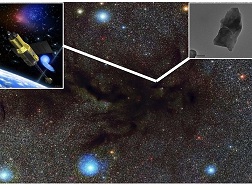– Airbus Defence and Space Netherlands rondt bouw- en testfase succesvol af – Tropomi definitief verenigd met Europese aardobservatiesatelliet Sentinel 5 Precursor – Analyse testfase bevestigt: toekomstige metingen door Tropomi zeer nauwkeurig Na een succesvolle afronding van de bouw- en testfase is het Nederlandse aardobservatie-instrument Tropomi de afgelopen weken op de Sentinel 5 Precursor satelliet …
Category: News items
Student lays technology foundation for balloon mission camera
Last week TU Delft student XuXiang Liu obtained his Msc degree in Electrical Engineering. XuXiang, who graduated with cum laude, was the very first student in Electrical Engineering who did his graduation project at SRON. At SRON he laid a solid technology foundation for the proposed cameras of the NASA balloon borne observatory GUSTO. Xuxiang …
Students from Groningen repeat Nobel prize experiment
Op 20 mei 1964 maten Arno Allan Penzias en Robert Woodrow Wilson voor heet eerst het nagloeien van de Big Bang. In 1978 ontvingen ze daarvoor de Nobelprijs. Op donderdagochtend, 2 juli 2015, hebben vier bachelorstudenten deze meting herhaald op het balkon van het Kapteyn Instituut, de sterrenkundeafdeling van de Rijksuniversiteit Groningen. De ontvanger waarmee …
Important steps on the road to structural cooperation with China
SRON heeft weer een paar belangrijke stappen gezet op weg naar een structurele samenwerking met de Chinese ruimtevaart. SRON trekt hierbij samen op met TNO, NSO, de Nederlandse overheid en andere Nederlandse ruimtevaartorganisaties en -instituten. In het oog springt vooral een CO2-missie die met Chinees geld van de grond moet gaan komen. Een cluster van …
Neutron star imitates black hole
An international team of astronomers – including SRON-researcher Peter Jonker – has found a neutron star which acts like a black hole in many ways. An extraordinary set of rings surrounding the neutron star system led to the conclusion that the neutron star is very bright at times and that it produces jets with at …
Solving the primeval dust puzzle
SRON researcher Elisa Costantini will receive a Vidi grant from Dutch science financier NWO. Costantini and her team will study the primaeval dust in the interstellar medium to shed new light on for instance star formation and the formation of planets. With the grant, which will add up to a maximum of 800.000 euros, Costantini …
Willem Jellema defends thesis on optical performance HIFI
Op vrijdag 1 mei verdedigt SRON-onderzoeker Willem Jellema zijn proefschrift aan de Rijksuniversiteit Groningen. In zijn proefschrift Optical Design and Performance Verification of Herschel-HIFI behandelt Jellema hoe de optische prestaties van de Nederlandse moleculenjager HIFI, één van de drie instrumenten aan boord van de Herschel-ruimtetelescoop (ESA, 2009-2013), tot stand zijn gekomen. Jellema heeft op dit terrein …
SRON present at Hannover Messe 2015
SRON staat samen met andere NWO-instituten op de technologiebeurs Hannover Messe 2015, die van 13 tot 17 april duurt. De NWO-stand maakt deel uit van het Holland High Tech-paviljoen, waar ook de Nederlandse ruimtevaartsector (NL Space) een stand heeft. SRON is op beide stands vertegenwoordigd met demonstratieopstellingen van ruimtetechnologie. In het Holland High Tech House, …
Financial support for museum and observatory Sonnenborgh
Sonnenborgh – museum & sterrenwacht ontvangt eenmalig extra steun voor een gezonde toekomst. De Gemeente Utrecht, de Universiteit Utrecht, pandeigenaar K.F. Hein Fonds Monumenten en de Stichting Vrienden van Sonnenborgh hebben hiertoe besloten. In totaal betreft het bijna €400.000 zowel in geld als in natura. Sonnenborgh – museum en sterrenwacht Directeur Bas Nugteren: “Wij zijn …
Millions for intermediate black holes and revolutionary redshift instrument
The European Research Council has awarded SRON researchers Jochem Baselmans (2.4 million euros) and Peter Jonker (2 million euros) prestigious research grants for independent groundbreaking research. Jonker will chase intermediate-mass black holes to find out if they really exist. Baselmans will develop a revolutionary instrument to measure the redshift of submillimeter galaxies, distant galaxies that …












